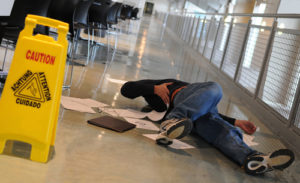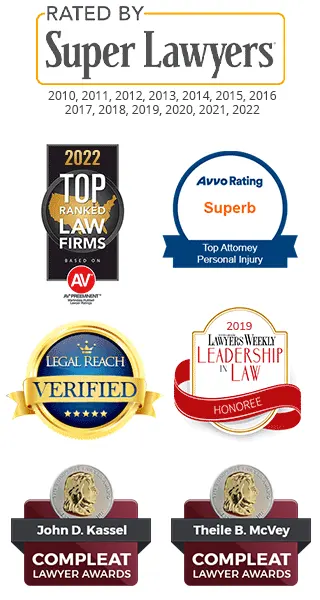

South Carolina Premises Liability / Slip and Fall Lawyers
 We often find ourselves on the premises or land of another for various reasons – perhaps we are parking our vehicle in a parking lot, shopping in a store, or attending a business meeting. Landowners are expected to keep their premises in reasonably safe condition, and so we have no reason to believe that the premises contain any hidden defects or other dangers.
We often find ourselves on the premises or land of another for various reasons – perhaps we are parking our vehicle in a parking lot, shopping in a store, or attending a business meeting. Landowners are expected to keep their premises in reasonably safe condition, and so we have no reason to believe that the premises contain any hidden defects or other dangers.
Each year, however, thousands of people sustain injuries while on the property of another. A person slips and falls on the floor, falls down a flight of stairs, or trips over an uneven patch of ground. The area of law regarding the liability of property owners for personal injury is called Premise Liability.
Under the South Carolina premises liability law, business owners and homeowners have a duty to keep their premises reasonably safe. Owners typically have a duty not to create a dangerous condition on their property and to remove or fix a dangerous condition upon receiving notice of the problem. Notice can be actual or constructive. Actual notice refers to knowledge a person subjectively possesses. Constructive notice refers to knowledge a person should have known. For example, failure to remedy a hazard after a reasonable time for inspection of the premises may trigger constructive knowledge. And it’s the failure to fix the problem which forms the basis for liability.
If you or someone you love is seriously injured on another person’s property due to no fault of your own, contact an experienced personal injury lawyer as soon as possible. We at Kassel and McVey can evaluate your case to determine if you have grounds for a claim and help you recover full and fair compensation for the damages stemming from your accident.
Establishing Negligence
South Carolina premises liability law allows property visitors a chance to file a civil claim against a landowner if the visitor suffered injuries while on that property. In order to succeed in such claim, the injured individual must establish that the landowner was negligent, and that his or her negligent actions led to the victim’s injuries.
Establishing negligence in a premises liability action involves proving the following:
Visitor Classifications
When it comes to premises liability in South Carolina, the obligation or duty of the landowner is typically based on the status or classification of the individual entering the land. There are four accepted classifications of individuals present on the property of another:invitees, licensees, trespassers, and children.
An invitee is someone on the property by invitation for the landowner’s advantage. An invitee could take the form of a customer purchasing items at a grocery store, for instance. The highest duty of care is owed to invitees. The property owner owes the customer the duty of exercising reasonable care for the visitor’s safety. Reasonable care may involve refraining from constructing dangerous conditions on the premises and then inviting others onto the premises. Reasonable care may involve repairing dangerous conditions in a timely fashion after actual or constructive notice. Finally, reasonable care may involve warning visitors of a dangerous condition. If any injuries result from the property owner’s breach of duty, the property owner will be held liable.
In contrast to an invitee, a licensee is an individual who is privileged to enter the property with the consent of the landowner. The primary benefit is the licensee’s and not the landowner’s. An example could be a guest attending a social gathering at a home. The duty owed by the landowner to the licensee is 1 to use reasonable care to discover the licensee, to conduct activities on the land so as not to harm the licensee, and to warn the licensee of any known concealed dangerous conditions or activities. The duty owed to a licensee differs from the duty owed to an invitee in that the landowner has no duty to search out and discover dangers or defects in the land (a duty to inspect) or to otherwise make the premises safe for a licensee.
Adult trespassers are owed no duty of care, except the duty not to inflict upon him willful or wanton injury. Children, on the other hand, are owed varying degrees of duty depending on their age and capacity.
What is a dangerous condition
If someone falls while on another’s property due to personal clumsiness there will be no legal responsibility or liable for the property owner. Liability springs from the presence of an unremedied dangerous condition. The person bringing the claim (the plaintiff) has the burden of demonstrating the existence of a dangerous condition or hazard. If a plaintiff cannot identify a defective condition as the cause of a fall or injury she will lose. Simply suggesting, for example, that a floor was slick without evidence that the slickness constituted an unsafe condition is not enough. Instead, the plaintiff would have to show the floor was unreasonably slick because of the presence of a foreign substance or improper waxing technique. Being able to identify the defect is key. A photograph of the offending condition is very helpful. Being injured on the property of another is not enough. The injury must be the product of an unreasonable and dangerous condition knowing allowed to exist on the premises.
Not everyone will likely agree on whether a condition is unreasonable and dangerous in a particular case. For instance, say a customer trips over a small crack in a cement sidewalk leading up to the entrance to a business. Is the crack an unreasonable and dangerous condition? Since it was large enough to become a tripping mechanism, then perhaps it should be deemed an unreasonable hazard. However, small cracks are ubiquitous. They dot the urban landscape. Will a fact finder really find a landowner liable for failing to correct every single crack or are they just a part of living? At Kassel McVey we have handled numerous fall cases due to “cracks” or defects as a tripping mechanism. Tolerating some defects is reasonable while tolerating others is not. We look at the following questions: the size and dimension of the defect; whether the defect is in a main walkway; the visibility of the defect; whether there are other competing objects for attention in the immediate area; how long the defect has existed; whether there have been other injuries caused by the defect; the ease in eliminating the defect.
Consider the following cases we have handled. In a parking lot fall case, our client was injured as she stepped out of her vehicle into a small hole in the asphalt that caused her to lose her balance and fall. The parking lot was littered with pot holes, raised edges and crumbling asphalt. The lot was clearly in need of repaving. We demonstrated that fact by photographing several adjacent parking lots in excellent repair with shiny, smooth black pavement.
In another case, our client was running toward a public school breezeway with a covered roof to avoid a sudden heavy rain shower. She was a licensee prompting a reduced duty of care. The school was aware they had draped a low hanging chain across the walkway. The chain was about ankle height. At one time the purpose of the chain was to keep vehicles from driving across the wide walkway. However over time the school erected a row of metal stanchions for that purpose. The school however never removed the chain. It had no legitimate function. It was at the perfect tripping height. It was hard to see in the rain (not to mention at night). It was an unreasonable hazard. Our client fell landing on her elbow causing a severely comminuted and displaced fracture which resulted in permanent injury.
In a complex premises liability case Kassel McVey represented a worker who contracted Mesothelioma, a form of cancer of the lining of the lung, almost always associated with exposure to asbestos. Asbestos is a natural mineral product. It is an efficient natural insulator, resists corrosion, and is a fibrous binding agent. At one time, asbestos was used by manufacturers to form insulation and gaskets for valves, pumps and other industrial machinery. Our client worked in an industrial plant providing maintenance. Part of his job was scrapping off old asbestos gaskets inside of various valves and pumps. After years of exposure the client developed mesothelioma. We decided to use premises liability principles to bring an action against the plant owner. The plant management had actual knowledge of the dangers posed by asbestos in its plant, yet failed to remedy the problem or even warn workers who might be exposed.
Statute of Limitations
If you were injured while on the property of another and wish to file a claim, it is crucial that you act immediately. South Carolina statute of limitations require you to file your case within three years from the date the accident occurred. Failure to take action within three years means no longer being able to bring your case to court. Actions against the state of South Carolina and its political subdivisions enjoy a two year statute of limitations.
Contact Kassel McVey Today
At Kassel and McVey, we have years of experience in successfully handling accident cases.
If you have been seriously injured and have reason to believe you have grounds for a premises liability claim, contact us as soon as possible. We will investigate the circumstances of the accident, gather evidence, and hold the responsible party accountable for their negligent actions. We will help you recover compensation for your medical bills, lost wages, and any other accident-related damages.
Call us today at (803) 256-4242 for a free case evaluation.
Personal Injury Lawyers 1330 Laurel Street Columbia, SC 29201 Phone: 803-256-4242
Mailing Address
Post Office Box 1476
Columbia, South Carolina 29202
Fax: (803) 256-1952
Copyright © 2023 John D. Kassel, Attorney at Law, LLC. All rights reserved. Privacy Policy I Terms of Service | Disclaimer
This website is designed for general information only. The information should not be construed to constitute formal legal advice or the formation of a lawyer/client relationship. The results and testimonials listed on this website are specific to the facts and legal circumstances of specific cases and should not be used to form an expectation that the same results could be obtained for other clients in similar matters. This list is not a description or characterization of the quality of the firm's representation, it is not intended to compare one attorney's work to another and is in no way a guarantee of a specific result for your case.

